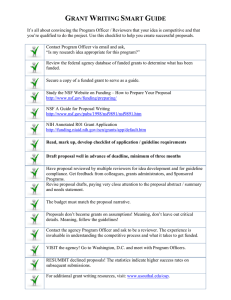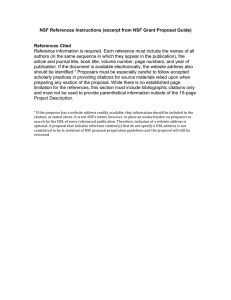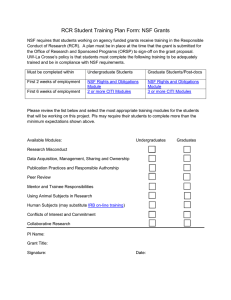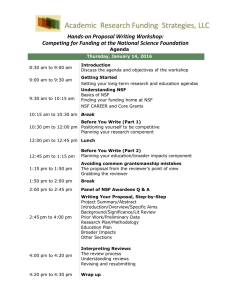Seeking Grant Support from the National Science Foundation
advertisement
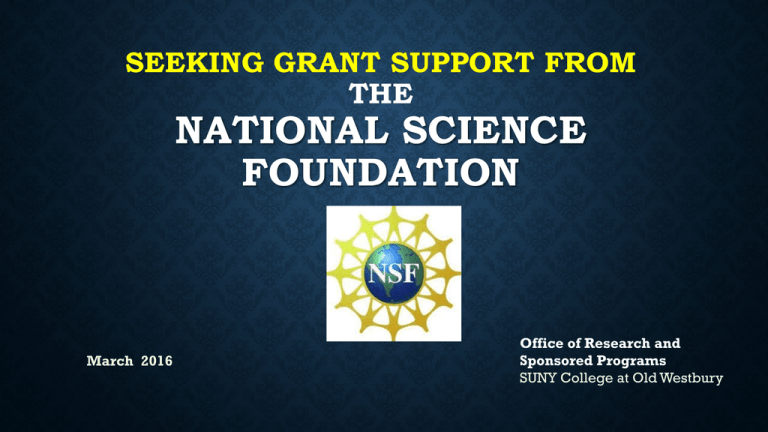
SEEKING GRANT SUPPORT FROM THE NATIONAL SCIENCE FOUNDATION March 2016 Office of Research and Sponsored Programs SUNY College at Old Westbury NSF at a glance… The National Science Foundation (NSF) is an independent federal agency created by Congress in 1950 "to promote the progress of science; to advance the national health, prosperity, and welfare; to secure the national defense…" The agency’s origins… Science The Endless Frontier A Report to the President by Vannevar Bush, Director of the Office of Scientific Research and Development, July 1945 Basic scientific research is scientific capital… How do we increase this scientific capital? First, we must have plenty of men and women trained in science, for upon them depends both the creation of new knowledge and its application to practical purposes. Second, we must strengthen the centers of basic research which are principally the colleges, universities, and research institutes. These institutions provide the environment which is most conducive to the creation of new scientific knowledge… It is only the colleges, universities, and a few research institutes that devote most of their research efforts to expanding the frontiers of knowledge… The most important ways in which the Government can promote industrial research are to increase the flow of new scientific knowledge through support of basic research, and to aid in the development of scientific talent. Vannevar Bush Cover-letter, Report to the President July 25, 1945 NSF leadership: • Director who oversees NSF staff and management responsible for program creation and administration, merit review, planning, budget and day-to-day operations; • National Science Board (NSB) composed of 24 eminent individuals that meets six times a year to establish the overall policies of the foundation. 6 year terms. And who reviews/judges grant proposals? You do…you and your colleagues through the agency’s merit review process. See accompanying workshop handout. The NSF’s merit review process will be described in greater detail later in this program. Looking ahead, is President Obama putting NSF dollars at risk changing the traditional means of budgeting research? Budgeting some as Mandatory spending and other as Discretionary? NSF provides support for research and training in all fields of fundamental science and engineering, except for medical sciences. So… How do I apply for NSF funding? How do I know if my ideas can be funded? How do I know how much funding to request? Who or where do I go for help? The Office for Research & Sponsored Programs is a good place to start… How do I apply? Electronically, uploading PDFs, using either • NSF’s FastLane https://www.fastlane.nsf.gov • GRANTS.GOV http://www.grants.gov/com or IMPORTANT: All applicants must be registered with NSF through FastLane, whether they pan to use Grants.gov or FastLane for purposes of proposal submission.. At Old Westbury, faculty register in FastLane through Tom Murphy. Registering with NSF through FastLane: • Provide the College’s director of ORSP (Tom Murphy) with: • Your name -- exactly how you wish it to appear. Do you use your middle name or a middle initial? Do you hyphenate? Do you use a suffix such as Jr. or III? • Your professional phone number and e-mail address, normally your Old Westbury telephone and e-mail, but not always… • Your terminal degree, the year conferred and academic discipline, which is not necessarily the same as your current academic department. Preparing your proposal in FastLane… Preparing your proposal in GRANTS.GOV… Preparing a project budget… A routine assignment for college ORSPs, as Isn’t your time better spent on the science? • Salary limit for PI imposed by NSF: 2 months • COLA or contractual increases: Consult ORSP for current actuals or latest projections. At present, I would suggest a 1.5% annual increase. • Employee Benefits: Consult ORSP for latest projections or to provide calculations. Today: PI summer, 15% S&W; undergrad student, 5%; regular employ, 45%. • Indirect Costs: a.k.a. Facilities & Administrative (F&A) Costs. 59.7% MTDC. Rate Agreement approved by DHHS on August 27, 2013. See handout. How do I know if my ideas can be funded? How do I know how much funding to request? STEP 1: Let’s return to the NSF website and find out about previous awards in your field. Go to: http://www.nsf.gov/awardsearch/ STEP 2: Let’s contact an NSF program officer. How do I know if my ideas can be funded? www.nsf.gov/funding/ • Program announcements • But see, also, the agency’s history of awards – award abstracts… 1 2 3 4 5 6 Part 1 - Grant Proposal Guide Part 2 - Post Award regulations Proposal content and formatting 𝑇𝑇𝑇𝑇𝑇𝑇𝑇𝑇𝑇𝑇𝑇𝑇𝑇𝑇𝑇𝑇𝑇𝑇𝑇𝑇𝑇𝑇 𝑀𝑀𝑀𝑀𝑀𝑀𝑀𝑀𝑀𝑀: 𝑭𝑭𝑭𝑭𝑭𝑭𝑭𝑭𝑭𝑭𝑭𝑭𝑭𝑭𝑭𝑭 𝑮𝑮𝑮𝑮𝑮𝑮𝑮𝑮𝑮𝑮𝑮𝑮. 𝒈𝒈𝒈𝒈𝒈𝒈 Beware! similar documents, but different! Target dates: dates after which proposals will still be accepted, although they may miss a particular panel or committee meeting. Deadline dates: dates after which proposals will not be accepted or will be returned without review by NSF. The deadline date will be waived only in extenuating circumstances. Applications are due by 5:00 pm sharp (local time) on any given deadline date. Flexibility in meeting announced deadline dates because of a natural or anthropogenic disaster that impacts a proposer’s ability to submit a proposal to NSF may be granted with the approval of the cognizant NSF Program Officer. Letters of intent or preliminary proposals also follow the 5 p.m. submitter's local time standard Grant applicants should allow up to six months for programmatic review and processing of their proposal. In addition, proposers should be aware that the NSF Division of Grants and Agreements generally makes awards within 30 days after the program division/office makes its recommendation. Bottom line: Expect an approved Project Start date a full 7 – 9 months after proposal submission Emergency need for funds? Contact your Office of Research and Sponsored Programs concerning possible approval of Pre-Award Costs – the ability to “advance” funds up to 90-days. Official Project Start Date: May 1 Start date with approval of Pre-Award Costs: February 1 Preliminary Proposals and Letters of Intent Some NSF program solicitations require or request submission of a preliminary proposal or a Letter of Intent in advance of submission of a full proposal. • To reduce the potential grant applicant’s unnecessary effort in proposal preparation when the chance of success is very small. This is particularly true in the case of competitions that will result in a small number of awards; • To assist NSF program staff in managing the review process and in the selection of reviewers. • To improve the overall quality of the full submission – assuring that applicants are, indeed, “on track” with the program solicitation’s intent. (E.g., Planning Grants vs Implementation Grants) Metric System Proposers are encouraged to use the Metric System of weights and measures in proposals submitted to the Foundation. Grantees also are encouraged to use metric units in reports, publications and correspondence relating to proposals and awards. (Ref: The Metric Conversion Act of 1975, as amended, and Executive Order 12770 of 1991). Proprietary or Privileged Information Patentable ideas, trade secrets, privileged or confidential information, disclosure of which may harm the proposer, should be included in proposals only when such information is necessary to convey an understanding of the proposed project. Such information must be clearly marked in the proposal and be appropriately labeled with a legend such as, "The following is proprietary information that the applicant, SUNY College at Old Westbury, requests not be released to persons outside the Government, except for purposes of review and evaluation." Prior to submission, it is strongly recommended that proposers conduct an administrative review to ensure that proposals comply with the proposal preparation guidelines. Be assured, the College’s Office of Research and Sponsored Programs (ORSP) will conduct a similar review, but only as time truly permits. If an application is not submitted to the ORSP in a timely manner, our review of the proposal may be limited and our collective ability to take corrective actions similarly limited. Use our NSF Grant Application Checklist, which will soon be made available from the ORSP website, to assist in this review. The checklist is not intended to be an all-inclusive repetition of the required proposal contents and associated proposal preparation guidelines. It is, however, meant to highlight certain critical items so they will not be overlooked when the proposal is prepared. • Use one of the following typefaces only: Arial, Courier New, or Palatino Linotype at a font size of 10 points or larger; Times New Roman at a font size of 11 points or larger; or Computer Modern family of fonts at a font size of 11 points or larger. A font size of less than 10 points may be used for mathematical formulas or equations, figures, table or diagram captions and when using a Symbol font to insert Greek letters or special characters. Applicants are cautioned, however, that the text must still be readable. • No more than 6 lines of text within a vertical space of 1 inch. • Margins, in all directions, must be at least 1 full inch. These requirements apply to all uploaded sections of a proposal, including supplementary documentation. List of Suggested Reviewers or Reviewers Not to Include An optional attachment, but generally considered very helpful to program officers. Proposers may include a list of suggested reviewers who they believe are especially well qualified to review the proposal. Proposers also may designate persons they would prefer not review the proposal, but must indicate why. Inclusion of such names is not required by the applicant; likewise, the use of either list is not guaranteed. Certification Regarding Responsible Conduct of Research (RCR) The College is required to provide appropriate training and oversight in the responsible and ethical conduct of research to undergraduates, graduate students, and postdoctoral researchers who will be supported by NSF to conduct research. When addressing RCR training at the College, one may wish to address Department-specific or Lab-specific training requirements, however, it is also important to cite the College’s use of CITI programs, accessible through the ORSP website. CITI training programs are held in high regard and originated using funding provided by the NSF. New… Certification Regarding Dual Use Research of Concern: The AOR* is required to complete a certification that the organization will be or is in compliance with all aspects of the United States Government Policy for Institutional Oversight of Life Sciences Dual Use Research of Concern. * Director, ORSP The College’s Local Approval Form Re: Lead time.
